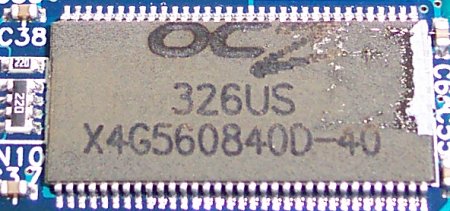Initial musings
PC4000, DDR500 and 250FSB running all boil down to the same thing. They're basically standards that are currently over and above what JEDEC, the governing body in all matters of system memory, ratify. Increasing a system's Front-Side Bus (FSB), assuming the processor and chipset can handle the speed, should, ceteris paribus, lead to enhanced performance. Why ?. Simply because raising it helps to reduce the bottleneck that exists between the CPU's and system's speeds. Wouldn't it be great if we could have system memory run at full CPU speed ?.
The pseudo PC4000 standard infers that modules run synchronously at 250FSB. That, then, becomes almost exclusively limited to the newest Intel chipsets. NVIDIA's nForce2 Ultra 400 is an elegant and powerful AMD chipset, but its Achilles Heel is a widely accepted North Bridge limit of ~ 230FSB. There are a number of nForce2 Ultra 400 boards that can and have hit 240FSB, yet we feel that we would be remiss in stating that as an average. On the other hand, Intel's dual-channel darlings have consistently shown an aptitude to hit 250FSB+, given that one had a CPU that was willing to oblige. So, assuming that memory latency was kept consistent, ramping up the FSB and running synchronous RAM should confer a substantial performance benefit. That, really, is PC4000 memory's raison d'etre.
It's now time to put aside theoretical talk and investigate OCZ's latest offering.

OCZ's custom premium packaging is out on show again. What we can glean from the above picture is that we have a 1GB (2x512MB) dual channel PC-4000 Enhanced Latency memory kit. Just a small point here; we're glad to see expensive modules ship in secure packaging. A company should attempt to mimimise the RMAs incurred through a poor delivery system. OCZ's packaging is one of the best around, we feel.

We've seen this kind of memory before, haven't we ?. Trademark copper heat spreaders on undisclosed RAM. The heat spreaders serve more than an aesthetic purpose. As you'll find out on the next page, this RAM to run at 2.8v. Copper, as well as looking good, is a decent heat conductor, and it should help reduce any localised heat build-up.
System RAM that's rated to DDR500 speeds is quite special, so we were eager to find out just how OCZ managed to bridge the gap between PC3700 and PC4000 memory speeds. There was only one way to find out, really. Off came the copper heat spreader. Please bear in mind that removing the heat spreader WILL invalidate the modules' warranty. We're simply removing one in the name of investigation.


What we have here is a double-sided 512MByte module using 16 256-Mbit OCZ-branded chips. You can clearly see the chips' imprint on the thermal tape that acts as a heat-transferring conduit between the RAM and copper 'spreader.

A close-up of a chip reveals that this doesn't appear to be a sanded Samsung chip, much like the ones used on OCZ PC-3700 Gold memory. OCZ's name and a 4.0ns rating (DDR500) speeds is all that we can meaningfully take away from the above picture. We have no method of discerning if these are true 4.0ns chips, simply because a manufacturer, in possession of a stamping machine, is open to marking its modules with whatever rating it wishes. The most important question that we'll be posing is whether these modules can run as a pair at DDR500 speeds. If they can, the chips' speeds become immaterial.









